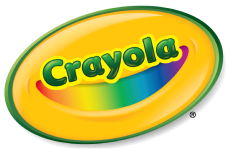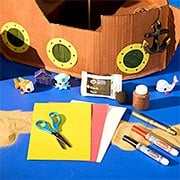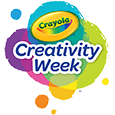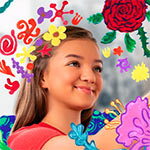Crayola® non ha inventato il pastello. Il pastello "moderno" ha origine in Europa, inizialmente realizzato con una miscela di carboncino e olio, successivamente sostituito da pigmenti in polvere. La cera è stata successivamente sostituita all'olio, rendendo i bastoncini più robusti e facili da maneggiare.
Nel 1902, i pastelli Crayola furono inventati da Binney & Smith e messi in vendita per la prima volta nel 1903. Il nome commerciale "Crayola" è stato coniato dalla signora Edwin Binney, combinando "craie" (francese per bastoncino di gesso) e "oleaginous" (oleoso).
Crayola produce oltre 3 miliardi di pastelli ogni anno, realizzati principalmente con cera di paraffina e pigmenti colorati. Scopri di più sulla colorata storia di Crayola sulla pagina della storia di Crayola.
If you have additional questions, we would love to hear from you! Feel free to call or text us at 1-800-CRAYOLA weekdays between 9 AM and 4 PM Eastern Time. If you would prefer to send us an email, visit our contact us page.
Domande Correlate
Esplora le risposte alle domande più frequenti, consigli utili per rimuovere le macchie e tante idee creative per sfruttare al meglio i nostri materiali artistici e le risorse gratuite.
-
The wife of the founder of our company, Alice (Stead) Binney, coined the name CRAYOLA Crayons. The name comes from "craie", the French word for chalk, and "ola" from oleaginous. This has been our trademark name since 1903 when our company was founded and remains one of the most important pieces of our heritage. The first box of Crayola Crayons was produced in 1903 as an 8 count box. It sold for a nickel and contained the colors red, orange, yellow, green, blue, violet, brown and black.
-
We value your commitment to recycling products you are no longer using.
At Crayola, our primary focus is on providing safe, high-quality products. To maintain the standards of safety and performance that our customers expect, we carefully select and screen raw materials for our crayons. Unfortunately, introducing recycled crayon wax into our manufacturing process would compromise these standards.
Crayola is committed to sustainability and environmental responsibility. To learn more about our efforts to support a greener planet, please visit our Sustainability Page.
-
Crayola Sidewalk Chalk is a molded chalk made of Plaster of Paris and color pigments. Although it is designed to be used on sidewalks and driveways, the chalk contains colorants, which may stain clothing and other household surfaces. If the chalk is used on a newly poured sidewalk or driveway, there is a possibility that the open surface pores in the concrete could absorb the colors.
We suggest testing Crayola Sidewalk Chalk in an inconspicuous area and then washing it away with water. In most cases, chalk markings wash away with the first rainfall if used on a paved or poured surface that is more than two years old.
Crayola offers stain removal suggestions as a service to consumers. You can find this information on the Crayola Stain Removal Tips page.
Please bear in mind that while all stain removal suggestions have been tested in our laboratory, results are not guaranteed. We recommend testing any suggestion in an inconspicuous area first.
If you have additional questions, we would love to hear from you! Feel free to call or text us at 1-800-272-9652 weekdays between 9 AM and 4 PM Eastern Time. If you prefer to send us an email, please visit the Crayola Contact Us page.
-
As we deepen our commitment to sustainability, we're researching what programs will make the most significant impact and help us advance our sustainability goals, like our commitment to significantly reduce emissions from our business operations by 2030.
We have already taken several steps to make our products and operations more sustainable by focusing our efforts on renewable energy and packaging initiatives.
- Renewable Energy: The 20-acre solar farm on our Crayola campus in Pennsylvania provides the electricity to make 1 billion crayons, 700 million markers a year, and 120 million jars of paint.
- Plastics Reduction: In the last 10 years, we've redesigned our broad line markers to save an estimated 2 million pounds of plastic versus its previous design.
- Packaging: We make our marker Classpack packaging with 100% recycled cardboard. Starting in 2023, this packaging, along with crayon sleeves, will be made with natural cardboard instead of bleached cardboard, which will reduce C02e emissions by an estimated 100 metric tons per year.
- Carbon Footprint: Crayola, through our parent company Hallmark, joined the Science Based Target initiative, a collaboration of global nonprofit organizations, businesses, and world governments that set goals to limit global warming to not exceed 1.5°C. To achieve this, participating organizations will need to reduce carbon emissions significantly by 2030. Crayola sources raw materials locally and manufactures many crayons and markers close to where they are used, which helps reduce the carbon footprint. In fact, Crayola has reduced CO2e emissions from our company-owned facilities' direct and indirect energy sources by 82% since 2019, with investments in renewable energy, as well as efficiencies in our US manufacturing process. (Direct energy includes the gasoline, oil, natural gas, etc. used while indirect emissions are created when the energy is produced but not where it is used.)
- Reforestation: Most Crayola colored pencils are made from wood that is reforested in an 8,288 hectare pine farm in Brazil. Each year 300,000 seedlings are planted to restore the forest.
For more information on Crayola sustainability efforts, check Crayola's Sustainability Page.
-
Because Crayola® Marker components are securely sealed during the manufacturing process, we don't recommend trying to remove the marker nib and reservoir to recycle the barrel. The marker caps can be recycled at facilities that accept #5 plastic.
Green is more than just a color to us! Learn more about Crayola's sustainability initiatives.



